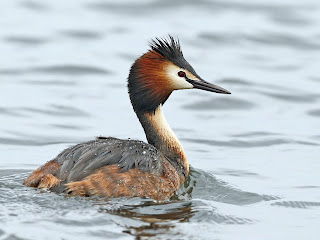Fulmar
Fulmarus
glacialis
 During
the breeding season, the stocky but brilliantly aerobatic fulmar is distributed
through Iceland, Ireland, Great Britain, Brittany, Greenland, Novaya Zemlya in
the Arctic Ocean and the western coast of Norway. At other times, it keeps to
the high seas. Both dispersive as well as migratory, it arrives at its nesting
grounds any time from December to April, assembling offshore in huge ‘rafts’.
Not until the end of April (more often in May or early June) does it move
ashore to cliffs or rocky islands. There it breeds in a colony sometimes
numbering hundreds or even thousands of birds of birds. The nests are unlined,
spaced between 1 and 5 meters apart, and places on rocky ledges. The female
lays one egg (occasionally two), which the partners take turns incubating for
about 52 days. The young are fed only once a day and during the first two weeks
are kept warm by one or other of the parents. They leave the nest after 48 to
57 days already capable of flight, but do not attain maturity until the age of
seven years. The fulmar feeds on pelagic mollusks, crustaceans and fish,
generally gathered from the surface. Only rarely does it dive and then to a
depth of 1 meter at the most.
During
the breeding season, the stocky but brilliantly aerobatic fulmar is distributed
through Iceland, Ireland, Great Britain, Brittany, Greenland, Novaya Zemlya in
the Arctic Ocean and the western coast of Norway. At other times, it keeps to
the high seas. Both dispersive as well as migratory, it arrives at its nesting
grounds any time from December to April, assembling offshore in huge ‘rafts’.
Not until the end of April (more often in May or early June) does it move
ashore to cliffs or rocky islands. There it breeds in a colony sometimes
numbering hundreds or even thousands of birds of birds. The nests are unlined,
spaced between 1 and 5 meters apart, and places on rocky ledges. The female
lays one egg (occasionally two), which the partners take turns incubating for
about 52 days. The young are fed only once a day and during the first two weeks
are kept warm by one or other of the parents. They leave the nest after 48 to
57 days already capable of flight, but do not attain maturity until the age of
seven years. The fulmar feeds on pelagic mollusks, crustaceans and fish,
generally gathered from the surface. Only rarely does it dive and then to a
depth of 1 meter at the most.|
Size of egg
|
67.0-81.43.2-54.8 mm
|
|
Length
|
47 cm. Male and female have similar plumage.
|
|
Voice
|
A horse, chuckling ‘ag-ag-ag-arrr’.
|








